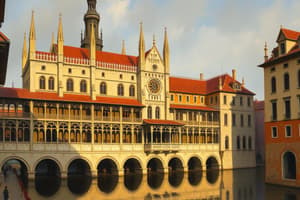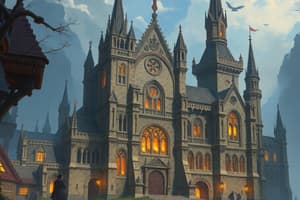Podcast
Questions and Answers
What distinguishes stained-glass windows from mural paintings and mosaics?
What distinguishes stained-glass windows from mural paintings and mosaics?
- They often depict historical events.
- They are easier to manufacture.
- They transmit light rather than reflect it. (correct)
- They conceal walls instead of replacing them.
Which term is defined as 'rebirth' in the context of a historical period in Europe?
Which term is defined as 'rebirth' in the context of a historical period in Europe?
- Gothic
- Romanticism
- Baroque
- Renaissance (correct)
Which of the following characteristics is NOT associated with Renaissance art?
Which of the following characteristics is NOT associated with Renaissance art?
- Realism
- Symbolism
- Obscurity of individual features (correct)
- Use of perspective
Who among the following is recognized as a master of Renaissance art?
Who among the following is recognized as a master of Renaissance art?
What was a significant technological advancement during the Renaissance period?
What was a significant technological advancement during the Renaissance period?
Which feature is quintessential to the concept of linear perspective invented by Renaissance artists?
Which feature is quintessential to the concept of linear perspective invented by Renaissance artists?
What aspect of Renaissance art aimed to capture the beauty and mystery of the natural world?
What aspect of Renaissance art aimed to capture the beauty and mystery of the natural world?
Which earlier method was primarily used by the clergy to introduce color in church interiors before the advent of stained-glass windows?
Which earlier method was primarily used by the clergy to introduce color in church interiors before the advent of stained-glass windows?
What does the cruciform shape of a cathedral represent?
What does the cruciform shape of a cathedral represent?
What architectural feature contributed to the thickness of cathedral walls in Romanesque architecture?
What architectural feature contributed to the thickness of cathedral walls in Romanesque architecture?
Which architectural innovation is associated with French Abbot Suger?
Which architectural innovation is associated with French Abbot Suger?
What function do the small semicircular chapels at the east end of the cathedral serve?
What function do the small semicircular chapels at the east end of the cathedral serve?
What was one consequence of the thick walls in Romanesque cathedrals?
What was one consequence of the thick walls in Romanesque cathedrals?
What is a key characteristic of the nave of St. Sernin?
What is a key characteristic of the nave of St. Sernin?
Which of the following elements were introduced during the Gothic architectural period?
Which of the following elements were introduced during the Gothic architectural period?
What was Abbot Suger's primary goal in developing Gothic architecture?
What was Abbot Suger's primary goal in developing Gothic architecture?
What characterizes one-point perspective in art?
What characterizes one-point perspective in art?
What transformation did artists undergo around the year 1500 in Western art?
What transformation did artists undergo around the year 1500 in Western art?
Which aspect of Leonardo da Vinci's 'The Last Supper' contributes to its depiction of human emotions?
Which aspect of Leonardo da Vinci's 'The Last Supper' contributes to its depiction of human emotions?
How does Leonardo da Vinci differ from medieval artists in his depiction of symbolism?
How does Leonardo da Vinci differ from medieval artists in his depiction of symbolism?
What is a significant feature of great Renaissance art, as exemplified by The Last Supper?
What is a significant feature of great Renaissance art, as exemplified by The Last Supper?
What was a significant consequence of the fall of the Western Roman Empire?
What was a significant consequence of the fall of the Western Roman Empire?
Which style of architecture evolved during the relatively peaceful period of 1000-1100?
Which style of architecture evolved during the relatively peaceful period of 1000-1100?
Which of the following accurately describes the population during the Medieval period?
Which of the following accurately describes the population during the Medieval period?
What architectural elements were adapted from the Roman style in Romanesque architecture?
What architectural elements were adapted from the Roman style in Romanesque architecture?
What was the primary unifying force during the Medieval period?
What was the primary unifying force during the Medieval period?
What characterizes the Romanesque style of architecture?
What characterizes the Romanesque style of architecture?
Which notable Romanesque church is mentioned as being one of the grandest?
Which notable Romanesque church is mentioned as being one of the grandest?
What cultural blend defined medieval society?
What cultural blend defined medieval society?
Flashcards
Medieval Period Beginning
Medieval Period Beginning
The Medieval period started after the fall of the Western Roman Empire, when Germanic tribes formed independent kingdoms.
Romanesque Architecture
Romanesque Architecture
A new architectural style from 1000-1100 that used Roman arch, barrel vaults, and groin vaults, and solid masonry walls.
Romanesque Revival
Romanesque Revival
A period of ambitious building projects following a peaceful era.
Pilgrimage Churches
Pilgrimage Churches
Signup and view all the flashcards
Saint-Sernin Cathedral
Saint-Sernin Cathedral
Signup and view all the flashcards
Gothic Art
Gothic Art
Signup and view all the flashcards
Medieval Society
Medieval Society
Signup and view all the flashcards
Medieval Architectural Revival
Medieval Architectural Revival
Signup and view all the flashcards
Cruciform Plan
Cruciform Plan
Signup and view all the flashcards
St. Sernin's Nave
St. Sernin's Nave
Signup and view all the flashcards
Barrel Vault
Barrel Vault
Signup and view all the flashcards
Pier
Pier
Signup and view all the flashcards
Romanesque Windows
Romanesque Windows
Signup and view all the flashcards
Gothic Architecture
Gothic Architecture
Signup and view all the flashcards
Flying Buttress
Flying Buttress
Signup and view all the flashcards
Abbey Church of St. Denis
Abbey Church of St. Denis
Signup and view all the flashcards
What is Gothic Architecture?
What is Gothic Architecture?
Signup and view all the flashcards
Stained Glass in Gothic Architecture
Stained Glass in Gothic Architecture
Signup and view all the flashcards
Renaissance
Renaissance
Signup and view all the flashcards
Key Characteristics of Renaissance Art
Key Characteristics of Renaissance Art
Signup and view all the flashcards
Linear Perspective
Linear Perspective
Signup and view all the flashcards
Impact of Renaissance Art
Impact of Renaissance Art
Signup and view all the flashcards
What is Realism in Art?
What is Realism in Art?
Signup and view all the flashcards
Individualism in Renaissance Art
Individualism in Renaissance Art
Signup and view all the flashcards
One-point perspective
One-point perspective
Signup and view all the flashcards
Artisans to Artists
Artisans to Artists
Signup and view all the flashcards
The Last Supper - Chaos and Order
The Last Supper - Chaos and Order
Signup and view all the flashcards
Naturalistic Symbolism
Naturalistic Symbolism
Signup and view all the flashcards
Study Notes
Western Medieval Architecture: The Renaissance
- The Medieval period began with the fall of the Western Roman Empire, marked by Germanic tribes forming independent kingdoms.
- This era was characterized by violence, illiteracy, and isolation; the majority of the population was poor and uneducated, with limited trade.
- Warfare, raids, and diseases led to a decline in population. Christianity served as the unifying force, blending Greco-Roman and Germanic traditions.
- Around 1000, a revival began with the emergence of Romanesque art.
- Around 1100, further economic, political, and artistic changes led to the Gothic Art period.
Romanesque Architecture (1000-1100)
- During a period of relative peace, towns and cities constructed ambitious building projects.
- Roman structures, like aqueducts, inspired architects.
- Roman innovations like arches, barrel-vaulted and groin-vaulted ceilings, and solid masonry walls—became influential.
- The new style, characterized by vaulted stone roofs, was called Romanesque.
- Religion played a role, as the 10th-12th centuries were a time of significant pilgrimages to Jerusalem, Rome, and Santiago de Compostela.
- Saint-Sernin in Toulouse, a notable pilgrimage church, exemplifies the grandeur and size of Romanesque cathedrals. It's the largest in Europe.
Romanesque Cathedral Features
- Cruciform or cross-shaped structure: The cathedral's central tower signified Christ's resurrection.
- Semicircular chapels: positioned at the east end of the cathedral; served as relic repositories for pilgrims without disrupting religious services.
- Nave: The main aisle presents itself as a long barrel vault with ceiling arches, a tunnel-like structure. The great weight of the stone ceiling required thick walls and thus smaller windows.
Gothic Architecture (1100 and beyond)
- French Abbot Suger is credited with inventing Gothic architecture.
- He aimed to make the Romanesque Abbey Church of St. Denis in France larger and lighter.
- To achieve this, Suger brought together the best architects in Europe to Paris.
- Key features that emerged are pointed arches, ribbed-groin vaults, and flying buttresses.
Flying Buttresses
- External supports (shown in illustrations) help hold up the massive roofs of Gothic cathedrals—like the Abbey Church of St. Denis.
Stained Glass Windows
- Stained-glass windows, though not a Gothic invention, are synonymous with Gothic architecture.
- The technique of creating stained glass originates from ancient Egypt and was further developed by Gothic artists.
- Stained glass offered a way to introduce color and religious iconography into church interiors and replaced walls, bringing light into the space.
Renaissance Architecture (14th - 16th Centuries)
- The time period following the Middle Ages saw a revival of interest in the classical learning and values of ancient Greece and Rome.
- "Renaissance" is a French word meaning "rebirth."
- A political stability and increased prosperity paved the way for new technologies like the printing press and advancements in astronomy and exploration. Exploration spurred philosophical and artistic growth.
- The Renaissance artistic style emerged in Italy in the late 14th century. Italy saw the high point from the late 15th through early 16th centuries.
- Leonardo da Vinci, Michelangelo, and Raphael were prominent examples of this era.
- Renaissance art sought to capture the experience of the individual and natural world—often employing classical Greco-Roman traditions.
Renaissance Art Characteristics
- Realism: Realistic portrayal of artistic styles and mastery of perspective and anatomy.
- Classical: Artistic work that includes classical forms and realistic techniques.
- Individualism: This style portrays the person as they are and seeks to describe their inner potential.
- Art as Philosophy: Art utilized symbolism, structure, posture, and color to depict realistic portrayals of people and places.
Birth of Linear Perspective
- Renaissance artists invented linear perspective.
- One-point perspective uses a single vanishing point, where lines converge as they recede into the distance. This creates a sense of depth and realism.
- Linear perspective is an exact science where the location of an object determines size.
High Renaissance (around 1500)
- Medieval artists perceived only God as the creator.
- By 1500, there was a shift in perspective; painters, sculptors, and architects became seen as creators of great works of artistic genius.
- Famous examples of Renaissance-era artists include Leonardo da Vinci, Raphael, and Michelangelo.
Features of Renaissance Art
- The Last Supper, despite damage, remains a masterpiece that portrays a spectrum of human emotions during a critical moment in Jesus’ ministry.
- The painting employs a finely balanced (bilateral symmetry) structure and incorporates symbolism—as evidenced by the sunset and sky—in a natural and realistic manner.
Studying That Suits You
Use AI to generate personalized quizzes and flashcards to suit your learning preferences.




